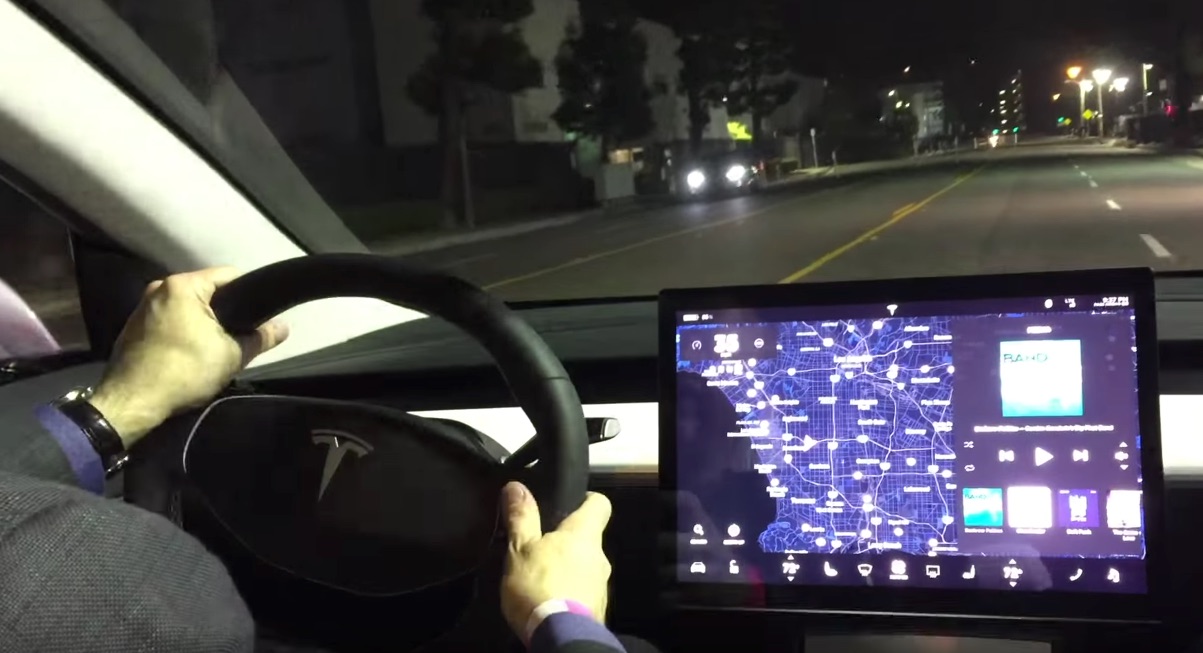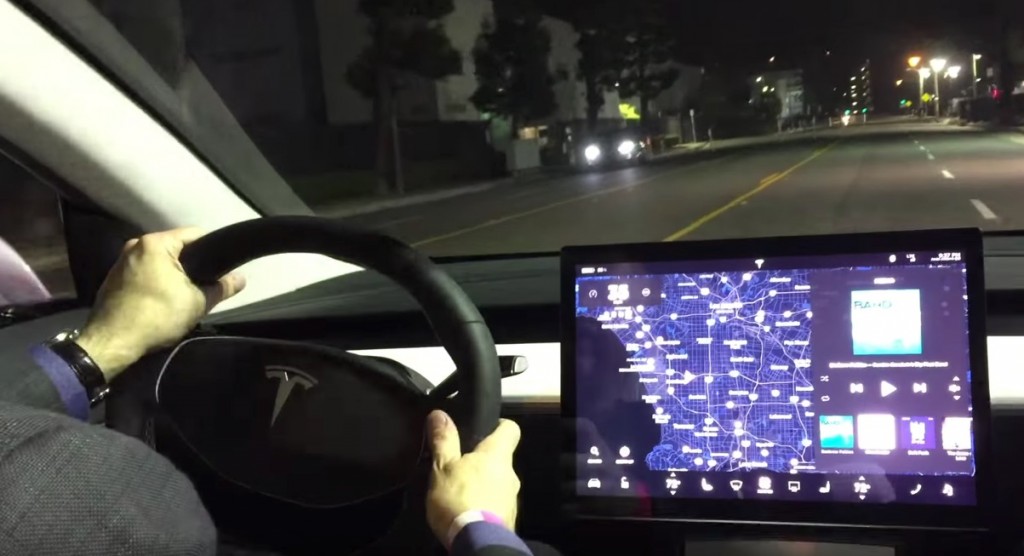News
Why Does the Model 3 Have No Instrument Cluster?
Why does the Model 3 have no instrument cluster? Maybe because the car is intended to be the fully autonomous self driving production vehicle.

The blogosphere is still buzzing about the Model 3 days after it was officially revealed to the public. A lot of that buzz is focused on the car’s interior, which features a dashboard with nothing attached except a 15″ horizontally mounted touchscreen. Is Tesla planning to add an instrument cluster similar to the ones found in the Model S and Model X before production begins?
Apparently not. Chris Zeigler, who covered the unveiling ceremony for The Verge, writes, “I was told by a Tesla staffer at last night’s event that the dash is essentially production-ready in its current state. In other words, the details may change, but the overall concept isn’t likely to change much; I would be shocked if a traditional instrument cluster magically sprouted between now and late 2017.”
What conclusion should we draw from the minimalist dashboard in the Model 3? It actually looks more like the inside of a Google bubble car than any conventional car you can think of. And that may be the biggest clue of all. Reddit user Red-Watcher may have figured it out first. He posted, “The Model 3’s lack of instrument cluster is a clear indication that the Model 3 itself was not necessarily designed to be driven, but rather designed for Tesla’s Autopilot technology to take the wheel.”
He goes on to say, “I think the near complete absence of operator control displays is a logical move from Tesla because they fully anticipate their Autopilot technology to dominant the means of Model 3 operation by the car’s late 2017 rollout date. Elon Musk has repeatedly said that full autonomy is 2 years away, and that doesn’t seem to far fetched to me after seeing the progress made with the Model S and X Autopilot tech.”
Chris Zeigler agrees. “The remaining explanation, I believe, is the biggest one: the Model 3 is a self-driving car. [B]y completely dispensing of the driver-centric cockpit in the Model 3, Tesla is signaling that it wants you to sit back and ride.” Keep in mind that Elon said during the reveal that the Model 3 would have a full compliment of Autopilot sensors.
It was just a few months ago that Elon Musk was tweeting that Tesla was seeking software engineers to develop autonomous driving systems, calling it a “super high priority.” At best, the first Model 3’s won’t be rolling off the assembly line until 18 months from now. That’s plenty of time for the company to further improve its autonomous driving capabilities.
By then, Tesla’s Autopilot equipped cars will have racked up a hundred million miles or more of near-autonomous driving, giving it perhaps the most advanced database of any manufacturer in the world. Why shouldn’t the Model 3 be the first self-driving production car?
There will need to be a lot of changes to existing state and federal laws before that prospect can become a reality. But Musk has said repeatedly that soon self driving cars will be as common as automatic elevators. Most of us just didn’t realize that “soon” would arrive this early.

News
Tesla FSD fleet is nearing 7 billion total miles, including 2.5 billion city miles
As can be seen on Tesla’s official FSD webpage, vehicles equipped with the system have now navigated over 6.99 billion miles.

Tesla’s Full Self-Driving (Supervised) fleet is closing in on almost 7 billion total miles driven, as per data posted by the company on its official FSD webpage.
These figures hint at the massive scale of data fueling Tesla’s rapid FSD improvements, which have been quite notable as of late.
FSD mileage milestones
As can be seen on Tesla’s official FSD webpage, vehicles equipped with the system have now navigated over 6.99 billion miles. Tesla owner and avid FSD tester Whole Mars Catalog also shared a screenshot indicating that from the nearly 7 billion miles traveled by the FSD fleet, more than 2.5 billion miles were driven inside cities.
City miles are particularly valuable for complex urban scenarios like unprotected turns, pedestrian interactions, and traffic lights. This is also the difference-maker for FSD, as only complex solutions, such as Waymo’s self-driving taxis, operate similarly on inner-city streets. And even then, incidents such as the San Francisco blackouts have proven challenging for sensor-rich vehicles like Waymos.
Tesla’s data edge
Tesla has a number of advantages in the autonomous vehicle sector, one of which is the size of its fleet and the number of vehicles training FSD on real-world roads. Tesla’s nearly 7 billion FSD miles then allow the company to roll out updates that make its vehicles behave like they are being driven by experienced drivers, even if they are operating on their own.
So notable are Tesla’s improvements to FSD that NVIDIA Director of Robotics Jim Fan, after experiencing FSD v14, noted that the system is the first AI that passes what he described as a “Physical Turing Test.”
“Despite knowing exactly how robot learning works, I still find it magical watching the steering wheel turn by itself. First it feels surreal, next it becomes routine. Then, like the smartphone, taking it away actively hurts. This is how humanity gets rewired and glued to god-like technologies,” Fan wrote in a post on X.
News
Tesla starts showing how FSD will change lives in Europe
Local officials tested the system on narrow country roads and were impressed by FSD’s smooth, human-like driving, with some calling the service a game-changer for everyday life in areas that are far from urban centers.

Tesla has launched Europe’s first public shuttle service using Full Self-Driving (Supervised) in the rural Eifelkreis Bitburg-Prüm region of Germany, demonstrating how the technology can restore independence and mobility for people who struggle with limited transport options.
Local officials tested the system on narrow country roads and were impressed by FSD’s smooth, human-like driving, with some calling the service a game-changer for everyday life in areas that are far from urban centers.
Officials see real impact on rural residents
Arzfeld Mayor Johannes Kuhl and District Administrator Andreas Kruppert personally tested the Tesla shuttle service. This allowed them to see just how well FSD navigated winding lanes and rural roads confidently. Kruppert said, “Autonomous driving sounds like science fiction to many, but we simply see here that it works totally well in rural regions too.” Kuhl, for his part, also noted that FSD “feels like a very experienced driver.”
The pilot complements the area’s “Citizen Bus” program, which provides on-demand rides for elderly residents who can no longer drive themselves. Tesla Europe shared a video of a demonstration of the service, highlighting how FSD gives people their freedom back, even in places where public transport is not as prevalent.
What the Ministry for Economic Affairs and Transport says
Rhineland-Palatinate’s Minister Daniela Schmitt supported the project, praising the collaboration that made this “first of its kind in Europe” possible. As per the ministry, the rural rollout for the service shows FSD’s potential beyond major cities, and it delivers tangible benefits like grocery runs, doctor visits, and social connections for isolated residents.
“Reliable and flexible mobility is especially vital in rural areas. With the launch of a shuttle service using self-driving vehicles (FSD supervised) by Tesla in the Eifelkreis Bitburg-Prüm, an innovative pilot project is now getting underway that complements local community bus services. It is the first project of its kind in Europe.
“The result is a real gain for rural mobility: greater accessibility, more flexibility and tangible benefits for everyday life. A strong signal for innovation, cooperation and future-oriented mobility beyond urban centers,” the ministry wrote in a LinkedIn post.
News
Tesla China quietly posts Robotaxi-related job listing
Tesla China is currently seeking a Low Voltage Electrical Engineer to work on circuit board design for the company’s autonomous vehicles.

Tesla has posted a new job listing in Shanghai explicitly tied to its Robotaxi program, fueling speculation that the company is preparing to launch its dedicated autonomous ride-hailing service in China.
As noted in the listing, Tesla China is currently seeking a Low Voltage Electrical Engineer to work on circuit board design for the company’s autonomous vehicles.
Robotaxi-specific role
The listing, which was shared on social media platform X by industry watcher @tslaming, suggested that Tesla China is looking to fill the role urgently. The job listing itself specifically mentions that the person hired for the role will be working on the Low Voltage Hardware team, which would design the circuit boards that would serve as the nervous system of the Robotaxi.
Key tasks for the role, as indicated in the job listing, include collaboration with PCB layout, firmware, mechanical, program management, and validation teams, among other responsibilities. The role is based in Shanghai.
China Robotaxi launch
China represents a massive potential market for robotaxis, with its dense urban centers and supportive policies in select cities. Tesla has limited permission to roll out FSD in the country, though despite this, its vehicles have been hailed as among the best in the market when it comes to autonomous features. So far, at least, it appears that China supports Tesla’s FSD and Robotaxi rollout.
This was hinted at in November, when Tesla brought the Cybercab to the 8th China International Import Expo (CIIE) in Shanghai, marking the first time that the autonomous two-seater was brought to the Asia-Pacific region. The vehicle, despite not having a release date in China, received a significant amount of interest among the event’s attendees.









